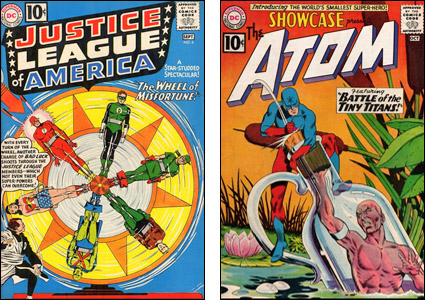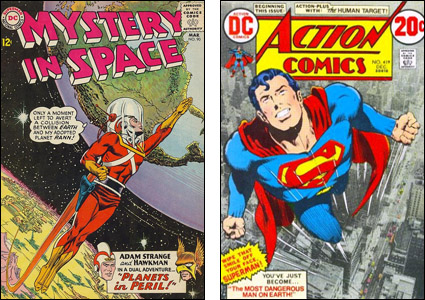Some folks were intrigued and/or puzzled when I mentioned that a couple of the artists whose comic book art was inked by Murphy Anderson weren't happy with the combination. Let me explain some things about comic book inking…
Most of the time, the way you produce inked line art is that the image is drawn in pencil and then once it's right (or close to right) in that medium, it's inscribed and finished in permanent ink and then whatever can be seen of the penciling is erased. In its purest form, one person does both but it is sometimes expedient or preferable to make it a collaboration. An artist who draws a syndicated newspaper comic strip generally has the option of doing it all himself (or herself) or assigning parts of the process out to others. Some choose to do it all themselves. Others decide to carve up the process and involve others.
There can be many reasons for turning it into a collaboration. The most often is time. There are fixed deadlines and a lot of work to do to meet them…and it's often easier for two or more to get the work done than for one person. There are also artists who are lazy and there are those who just plain more comfy drawing in pencil than ink or vice-versa. It can also be a creative decision. I think Garry Trudeau has someone else ink Doonesbury because he thinks it makes up for any weakness in his penciling, though time is also probably a factor.
That was all very common in newspaper strips before there was a comic book industry. When funnybooks came along, they made it much more common for one guy to pencil and another to ink. That decision was made by editors and publishers, not by artists. Regardless of whether it was preferable for the guys at the drawing tables, it was easier for the office.
For one thing, it kept the assembly line moving in one direction. If one guy penciled and inked his own work, he had to pencil it and then it had to go to a letterer to put in the copy, and then it had to be shipped back to the artist who was probably penciling the next job and had to stop doing that to ink the previous story. It was simpler for the editors to have an artist usually pencil or ink, not both.
For another thing, it increased volume. Let's say Artist A was a great artist and Artist B was not so great, maybe not even good enough to draw for your company. You might well decide that if you have B ink A, the resultant work is good enough to print. It might not be as good as if A finished it himself but, hey, now you've got twice as much to publish!
Or maybe if A and B are both just okay, B can fix A's art a bit to make it more publishable. The penciler/inker system can enable you to employ artists who aren't good enough to do it all on their own.

In going to that system, they largely created the situation where the penciler and inker might not have any contact. The penciler would hand the work in to the editor, often with no idea who'd be inking it. The inker would receive the job from the editor, ink in the pencil art, then turn it back in. Jack Kirby's penciling at Marvel in the sixties was inked (and inked well) by Joe Sinnott, and the two men neither met nor spoke until years later. Joe had to guess what Jack had in mind…and of course, he often rendered the art in ways that Jack never would have.
This, of course, can create wonderment on the pages when the right match is achieved and can ruin fine pencil work when it is not. It can also put the pencil artist in the position of feeling divorced from his own work because by the time it reaches the readers, a lot of it doesn't look like he intended it to look. It didn't bother Kirby because he preferred moving onto the next story than to spend more of his life finishing the last one. But Jack thought of himself more as a storyteller than as an illustrator. Most comic book artists thought of themselves mainly or wholly as artists.
Many comic fans will tell you that one of the great pairings occurred when John Buscema's pencil art on Conan was inked by Alfredo Alcala — a man who for much of their collaboration was living in another country. They were horrified when Buscema began saying that he hated what Alfredo did with his pencil art, how much he changed it and "lost" things that John wanted to see in the finished product.
There is a downside to doing that to pencilers. Imagine if you were a professional painter, producing lovely scenes on canvas. Imagine then that the guy who paid you then took your paintings and gave them to someone who changed so much of what you did that some of it was unrecognizable to you and much of what you did was obliterated. You might take less pride in your work…or figure, "Why am I trying to hard to get this right?" It might make it harder for you to give the work your all. You might feel less like an artist and more like a tiny cog in a big machine. (Some comic book publishers have not been unhappy when the artists think of themselves that way instead of as important contributors. Tiny cogs are less likely to demand raises.)
The problems described in the previous paragraph were not huge ones in the first few decades of comic books. The talent pool consisted of men (almost all men) who grew up in the Depression Era and were happy to have work…any work. They often did not sign their work. They usually drew whatever they were asked to do. They might not care to ink only or to work on horror comics but if the available work at that moment was inking horror comics, they inked horror comics. Some of them were so good that even when they were not at their best, the work was still good enough.

When Gil Kane's pencil art was inked by Murphy Anderson at DC, you had the teaming of two men who, paychecks aside, would have each preferred to do the work on their own. Murphy thought of himself as an artist, not a finisher of someone else's art. Gil looked at the finished pages and thought, "That's not my drawing. It's someone changing my drawing!" Many of us readers looked at the printed comics and thought, "That's great!" — and it was great because they were two very talented men. But it might not have been the ideal working situation for them. Murphy, I know, was not thrilled to go through long periods as an inker, essentially not using two-thirds of his talents.
Today, if a kid wandered into the business with the skill set of Murphy Anderson, I doubt he'd find himself in that situation. For one thing, he might not be as desperate to make a steady living as a kid born, as Murphy was, three years before the big Stock Market crash of '29. For another, his name would be on all his work and he might care a lot about his reputation…and about the sales value of his original art. The business might also care more than it once did about the artist being happy with how his work came out. They'd recognize that better, more saleable work would probably result and they'd also want to keep an artist that good from jumping to the competition.
(By the way: In the above paragraph, everywhere I said "his," I probably should have said "his or her." Another thing that's happily changed.)
I could fill this blog for a whole year with postings about how the comic book field has changed. That's one. The way artists approach their work has changed…generally for the better, I think. Murphy Anderson produced wonderful, wonderful work during his time in comics and I don't mean to criticize a single panel of it. I just think he, like a lot of his contemporaries, could have been deployed better if they'd been treated less like warm bodies to fill up pages and more like the total artists they were.
And I say that even though Adam Strange, as penciled by Carmine Infantino and inked by Murphy Anderson, looked real, real terrific to me.